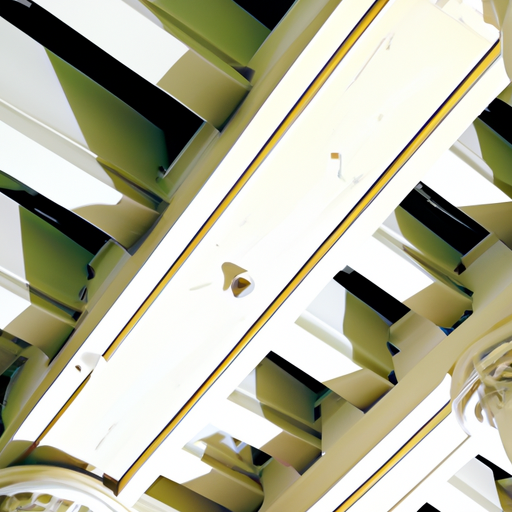Timeless Elegance: Incorporating Classic Architectural Features in Luxury Design
Designing for luxury is an art that requires a deep understanding of the key architectural elements that contribute to creating an atmosphere of timeless elegance. Incorporating classic architectural features in luxury design is essential to achieving a sophisticated and opulent aesthetic that transcends trends and remains relevant for years to come. This article will explore some of the most important architectural elements that can be used to create a luxurious and timeless design.
One of the most significant aspects of designing for luxury is the use of proportion and scale. A well-proportioned space is not only visually appealing but also creates a sense of harmony and balance. In classical architecture, the use of the Golden Ratio, a mathematical principle that has been used for centuries to create aesthetically pleasing proportions, is often employed to achieve this balance. By incorporating the Golden Ratio into the design of a space, architects can create a sense of order and symmetry that is both visually pleasing and inherently luxurious.
Another key architectural element in luxury design is the use of high-quality materials. The choice of materials can greatly impact the overall aesthetic of a space, and selecting premium materials such as marble, hardwood, and natural stone can instantly elevate the level of luxury in a design. These materials not only provide a sense of opulence but also offer durability and longevity, ensuring that the space remains elegant and timeless for years to come.
In addition to the use of premium materials, the incorporation of intricate detailing and craftsmanship is essential in creating a luxurious design. This can be achieved through the use of ornate moldings, decorative plasterwork, and custom millwork. These elements not only add visual interest to a space but also demonstrate a level of skill and attention to detail that is synonymous with luxury design. By incorporating these intricate details into a space, architects can create a sense of refinement and sophistication that is truly timeless.
Lighting is another crucial element in designing for luxury. The use of carefully considered lighting can not only enhance the architectural features of a space but also create a warm and inviting atmosphere. In luxury design, the use of chandeliers, wall sconces, and other decorative lighting fixtures can add a touch of opulence and elegance to a space. Additionally, incorporating natural light through the use of large windows and skylights can create a sense of openness and grandeur that is essential in achieving a luxurious aesthetic.
Finally, the incorporation of classic architectural features such as columns, arches, and vaulted ceilings can greatly contribute to the overall sense of timeless elegance in a luxury design. These elements not only provide structural support but also serve as a visual reminder of the enduring appeal of classical architecture. By incorporating these features into a space, architects can create a sense of history and tradition that is both luxurious and timeless.
In conclusion, designing for luxury requires a careful consideration of key architectural elements that contribute to creating an atmosphere of timeless elegance. By incorporating classic architectural features such as proportion and scale, high-quality materials, intricate detailing, and thoughtful lighting, architects can create a sophisticated and opulent aesthetic that transcends trends and remains relevant for years to come. By understanding and utilizing these essential elements, architects can successfully design spaces that exude luxury and timeless elegance.
Opulent Spaces: Exploring the Role of Proportion and Scale in High-End Architecture

Designing for luxury is an art form that requires a deep understanding of the key architectural elements that contribute to opulence and grandeur. One of the most important aspects of high-end architecture is the creation of opulent spaces, which are characterized by their proportion and scale. These elements play a crucial role in defining the overall aesthetic and atmosphere of a space, and can greatly influence the perception of luxury and sophistication.
Proportion and scale are fundamental principles of architecture that have been studied and refined for centuries. They are essential in creating a harmonious and balanced environment, which is a hallmark of luxury design. Proportion refers to the relationship between the size of different elements within a space, while scale refers to the overall size of the space itself. By carefully considering these factors, architects can create spaces that exude opulence and elegance.
One of the most famous examples of the use of proportion and scale in architecture is the ancient Greek temple, the Parthenon. This iconic structure is renowned for its perfect proportions, which create a sense of harmony and balance. The architects of the Parthenon employed the Golden Ratio, a mathematical principle that has been used throughout history to create aesthetically pleasing designs. This ratio is believed to be the key to creating spaces that are visually appealing and evoke a sense of luxury.
In contemporary high-end architecture, proportion and scale continue to play a vital role in creating opulent spaces. One of the most effective ways to achieve this is through the use of high ceilings. High ceilings create a sense of grandeur and spaciousness, which is often associated with luxury. They also allow for the incorporation of large windows and doors, which can flood the space with natural light and create a sense of openness and connection to the outdoors.
Another important aspect of designing for luxury is the use of symmetry. Symmetrical designs are inherently pleasing to the eye and create a sense of balance and harmony within a space. This can be achieved through the careful placement of architectural elements, such as columns, archways, and windows. In high-end architecture, symmetry is often used to create a sense of order and refinement, which contributes to the overall perception of luxury.
In addition to proportion and scale, the choice of materials is also crucial in creating opulent spaces. High-quality materials, such as marble, granite, and hardwood, are often used in luxury design to create a sense of richness and sophistication. These materials not only provide a visually appealing aesthetic but also offer durability and longevity, which are important factors in high-end architecture.
The use of intricate detailing and craftsmanship is another key element in designing for luxury. Ornate moldings, intricate carvings, and custom-designed fixtures can all contribute to the overall sense of opulence within a space. These details not only showcase the skill and expertise of the craftsmen involved but also add a layer of depth and complexity to the design.
In conclusion, the creation of opulent spaces in high-end architecture relies heavily on the careful consideration of proportion and scale. By employing these principles, architects can create harmonious and balanced environments that exude luxury and sophistication. Additionally, the use of high-quality materials, symmetry, and intricate detailing further enhances the perception of opulence and grandeur. Ultimately, designing for luxury is a delicate balance of these key architectural elements, which work together to create spaces that are both visually stunning and functionally exceptional.
Material Mastery: The Art of Selecting Premium Finishes for Luxurious Interiors
Designing for luxury is an art form that requires a keen eye for detail, a deep understanding of the client’s desires, and a mastery of materials and finishes. The world of luxury interior design is one where opulence, elegance, and sophistication reign supreme. It is a realm where architects and designers must push the boundaries of creativity and innovation to create spaces that are not only visually stunning but also exude an air of exclusivity and refinement. One of the most critical aspects of designing luxurious interiors is the art of selecting premium finishes. This article will delve into the world of material mastery and explore the key architectural elements that contribute to the creation of truly luxurious spaces.
The foundation of any luxurious interior lies in the choice of materials and finishes. The selection of premium finishes can elevate a space from ordinary to extraordinary, creating an atmosphere of indulgence and grandeur. When selecting materials for a luxury project, architects and designers must consider not only the aesthetic appeal of the material but also its durability, functionality, and sustainability. Some of the most sought-after materials in luxury design include marble, onyx, travertine, and other natural stones, as well as exotic woods, precious metals, and fine leathers.
Marble, with its timeless elegance and natural beauty, has long been a favorite material for luxury interiors. Its unique veining and patterns make it an ideal choice for flooring, countertops, and wall cladding. Marble can be used in various finishes, including polished, honed, and brushed, each offering a different level of sheen and texture. Onyx, another natural stone, is prized for its translucency and vibrant colors, making it a popular choice for backlit wall panels and other decorative features. Travertine, with its earthy tones and distinctive pitted surface, adds warmth and character to any space.
Exotic woods, such as ebony, rosewood, and teak, are often used in luxury design for their rich colors, intricate grain patterns, and exceptional durability. These woods can be used for flooring, cabinetry, and furniture, adding a touch of sophistication and warmth to the space. Precious metals, such as gold, silver, and bronze, are also commonly used in luxury interiors, often as accents or decorative elements. These metals can be incorporated into lighting fixtures, hardware, and accessories, adding a touch of opulence and glamour to the space.
Fine leathers, whether used for upholstery, wall coverings, or custom furniture, can add an air of sophistication and luxury to any interior. The use of high-quality, supple leathers in rich, deep colors can create a sense of comfort and indulgence, while also providing durability and longevity.
In addition to the selection of premium materials, the art of designing for luxury also involves the careful consideration of architectural elements and details. This includes the use of intricate moldings, coffered ceilings, and custom millwork to create a sense of depth and dimension in the space. The incorporation of bespoke lighting solutions, such as chandeliers, sconces, and recessed lighting, can also contribute to the overall ambiance and atmosphere of a luxurious interior.
Furthermore, the use of well-curated art and accessories can add the finishing touches to a luxury space, creating a cohesive and harmonious design. This may include the incorporation of fine art, sculptures, and custom-designed furnishings that reflect the client’s personal tastes and preferences.
In conclusion, designing for luxury is a complex and multifaceted process that requires a deep understanding of materials, finishes, and architectural elements. By mastering the art of selecting premium finishes and incorporating them into well-designed spaces, architects and designers can create truly luxurious interiors that exude elegance, sophistication, and exclusivity.
Q&A
Question 1: What are the key architectural elements to consider when designing for luxury?
Answer 1: The key architectural elements to consider when designing for luxury include spacious layouts, high-quality materials, attention to detail, integration of technology, and incorporation of unique features such as bespoke lighting, custom-designed furniture, and art installations.
Question 2: How do architects create a sense of opulence and grandeur in luxury design?
Answer 2: Architects create a sense of opulence and grandeur in luxury design by using elements such as high ceilings, expansive windows, open floor plans, and the use of rich materials like marble, hardwood, and precious metals. Additionally, they may incorporate impressive architectural features like grand staircases, ornate moldings, and intricate detailing.
Question 3: What role does sustainability play in luxury architectural design?
Answer 3: Sustainability plays an increasingly important role in luxury architectural design, as clients seek environmentally-friendly solutions without compromising on luxury. This can be achieved through the use of energy-efficient systems, sustainable materials, green roofs, and incorporating natural elements into the design, such as natural light and ventilation.
Conclusion
In conclusion, designing for luxury involves incorporating key architectural elements such as grand entrances, spacious layouts, high-quality materials, innovative technology, and personalized amenities. These elements not only enhance the aesthetic appeal of the space but also provide an elevated living experience, reflecting the opulence and sophistication associated with luxury living.


